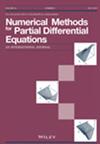二元流体-表面活性相场方程的能量稳定和保界数值方案的收敛性和稳定性分析
IF 1.7
3区 数学
Q1 MATHEMATICS, APPLIED
引用次数: 0
摘要
该模型由两个卡恩-希利亚德(Cahn-Hilliard)型方程组成,自由能包含金兹堡-朗道(Ginzburg-Landau)双井势、对数弗洛里-哈金斯(Flory-Huggins)势和非线性耦合熵。数值方案是解耦的线性方案,通过中心差分空间近似与基于自由能凸分裂的一阶和二阶指数时差法相结合而建立。为了保证方案的线性,对非线性项,尤其是对数项进行了显式近似,这就要求数值解的约束保持,从而使算法具有鲁棒性。我们对一阶和二阶方案进行了收敛分析,并详细证明了边界保持特性,其中高阶一致性分析适用于一阶情况。此外,还通过凸分裂的性质获得了能量稳定性。通过数值实验验证了方案的准确性和稳定性,并模拟了相分离和表面活性剂吸附的动力学过程。本文章由计算机程序翻译,如有差异,请以英文原文为准。
Convergence and stability analysis of energy stable and bound‐preserving numerical schemes for binary fluid‐surfactant phase‐field equations
In this article, we develop stable and efficient numerical schemes for a binary fluid‐surfactant phase‐field model which consists of two Cahn–Hilliard type equations with respect to the free energy containing a Ginzburg–Landau double‐well potential, a logarithmic Flory–Huggins potential and a nonlinear coupling entropy. The numerical schemes, which are decoupled and linear, are established by the central difference spatial approximation in combination with the first‐ and second‐order exponential time differencing methods based on the convex splitting of the free energy. For the sake of the linearity of the schemes, the nonlinear terms, especially the logarithmic term, are approximated explicitly, which requires the bound preservation of the numerical solution to make the algorithm robust. We conduct the convergence analysis and prove the bound‐preserving property in details for both first‐ and second‐order schemes, where the high‐order consistency analysis is applied to the first‐order case. In addition, the energy stability is also obtained by the nature of the convex splitting. Numerical experiments are performed to verify the accuracy and stability of the schemes and simulate the dynamics of phase separation and surfactant adsorption.
求助全文
通过发布文献求助,成功后即可免费获取论文全文。
去求助
来源期刊
CiteScore
7.20
自引率
2.60%
发文量
81
审稿时长
9 months
期刊介绍:
An international journal that aims to cover research into the development and analysis of new methods for the numerical solution of partial differential equations, it is intended that it be readily readable by and directed to a broad spectrum of researchers into numerical methods for partial differential equations throughout science and engineering. The numerical methods and techniques themselves are emphasized rather than the specific applications. The Journal seeks to be interdisciplinary, while retaining the common thread of applied numerical analysis.

 求助内容:
求助内容: 应助结果提醒方式:
应助结果提醒方式:


